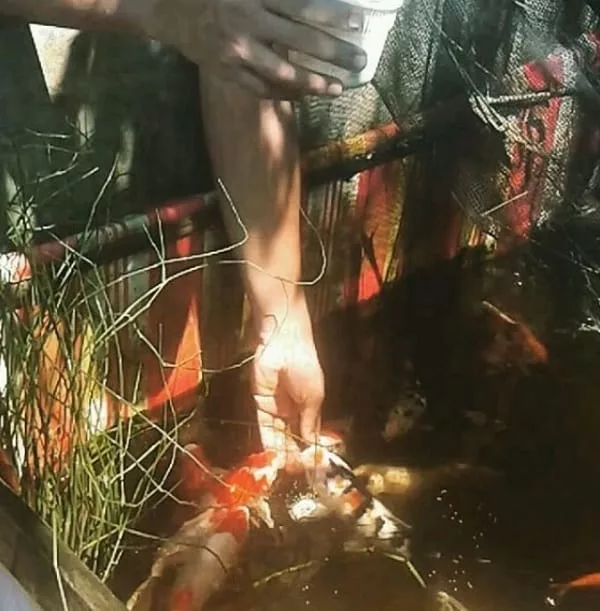Dive into the Delicious Diet of Koi: A Comprehensive Guide ????????
What Do Koi Fish Eat, The vibrant colors and graceful movements of koi fish make them a captivating addition to any pond or aquarium. But what fuels these majestic creatures? Unveiling the secrets of their diet is key to keeping your koi healthy and thriving.
What Do Koi Fish Eat in the Wild?
What Do Koi Fish Eat, Imagine a buffet teeming with algae, aquatic plants, insects, worms, and even small crustaceans. That’s the life of a wild koi! These omnivores scavenge the pond bottom, sifting through the sediment for tasty morsels. Their specialized mouths, devoid of teeth, are perfect for sucking up these diverse offerings. ????????????
What Do Koi Fish Like to Eat?
In captivity, you can become your koi’s personal chef, offering them a balanced diet that mimics their natural preferences. Here are some of their favorites:
- Commercial Koi Food: Formulated with essential nutrients, these pellets are the foundation of a healthy diet. Choose pellets appropriate for your koi’s size and water temperature. ????????️
- Fruits and Vegetables: Chopped lettuce, watermelon, and peas are delightful treats, but avoid citrus fruits. ????????
- Blanched Greens: Spinach, kale, and dandelion leaves provide valuable vitamins and minerals. ????????
- Live Food: Brine shrimp, bloodworms, and mosquito larvae are occasional protein-rich snacks. ????????
What Kind of Foods Do Pond Fish and Koi Eat?
What Do Koi Fish Eat, Remember, koi share their pond with other fish. Choose food that caters to everyone’s needs while avoiding competition and overfeeding. Opt for sinking pellets for bottom feeders like koi and floating flakes for surface dwellers. ????️????
What Plants Do Koi Fish Eat?
While koi nibble on algae and some aquatic plants, be mindful of overconsumption. It can disrupt the pond’s ecosystem. Choose algae-eating fish like goldfish or plecos to help maintain balance. ????????
What Do Baby Koi Fish Eat?
Tiny fry have smaller mouths and require food specifically designed for them. Look for finely ground flakes or live foods like infusoria and microworms. ????????
What Do Large Koi Fish Eat?
Larger koi need bigger bites! Opt for larger pellets formulated for their size and nutritional requirements. ????????️
What Do Koi Betta Fish Eat?
While both are stunning fish, koi and betta have different dietary needs. Bettas require a carnivorous diet, while koi are omnivores. Never feed betta food to koi. ????❌????
What Do Koi Pond Fish Eat?
Remember, your pond ecosystem hosts various fish. Choose a diverse food selection that caters to everyone’s dietary needs. ????????????
What Human Food Can Koi Fish Eat?
Occasional treats like chopped vegetables or fruits are okay, but avoid processed foods, bread, and dairy products. These can harm your koi’s health. ????????????
Can Koi Fish Eat Cucumber?
Yes, small amounts of cucumber are a refreshing treat for koi. However, remove the skin and seeds first. ????✂️
Koi Fish Food Homemade:
While tempting, homemade koi food often lacks essential nutrients. Stick to commercially prepared options formulated for optimal health. ????????
Best Food for Koi Growth:
High-quality koi food pellets enriched with protein and essential vitamins are ideal for promoting healthy growth. Consult your local pet store for expert recommendations. ????????????️
How to Feed Koi Fish in Aquarium:
Feed your koi 2-3 times daily, providing only what they can consume within 5 minutes. Overfeeding can pollute the water. ⏰????????
Conclusion:
Understanding your koi’s dietary needs is crucial for their well-being. By offering a balanced variety of foods and avoiding harmful options, you can ensure your vibrant companions thrive for years to come. ????????????
Frequently ask questions FAQs:
How often should I feed my koi?
2-3 times daily, with amounts they can finish within 5 minutes.
What is the best food for koi?
High-quality commercial koi pellets cater to their nutritional needs.
Can I feed my koi human food?
Occasional treats like vegetables are okay, but avoid processed foods, bread, and dairy.
What plants do koi eat?
They may nibble on algae and some plants, but excess consumption can harm the pond ecosystem.
You may also like
- https://www.giobelkoicenter.com/how-to-catch-koi/
- https://www.giobelkoicenter.com/indoor-koi-pond/
- https://www.giobelkoicenter.com/sanke-koi-fish/
- https://www.giobelkoicenter.com/butterfly-koi/
- https://www.giobelkoicenter.com/koi-fish-nft/
